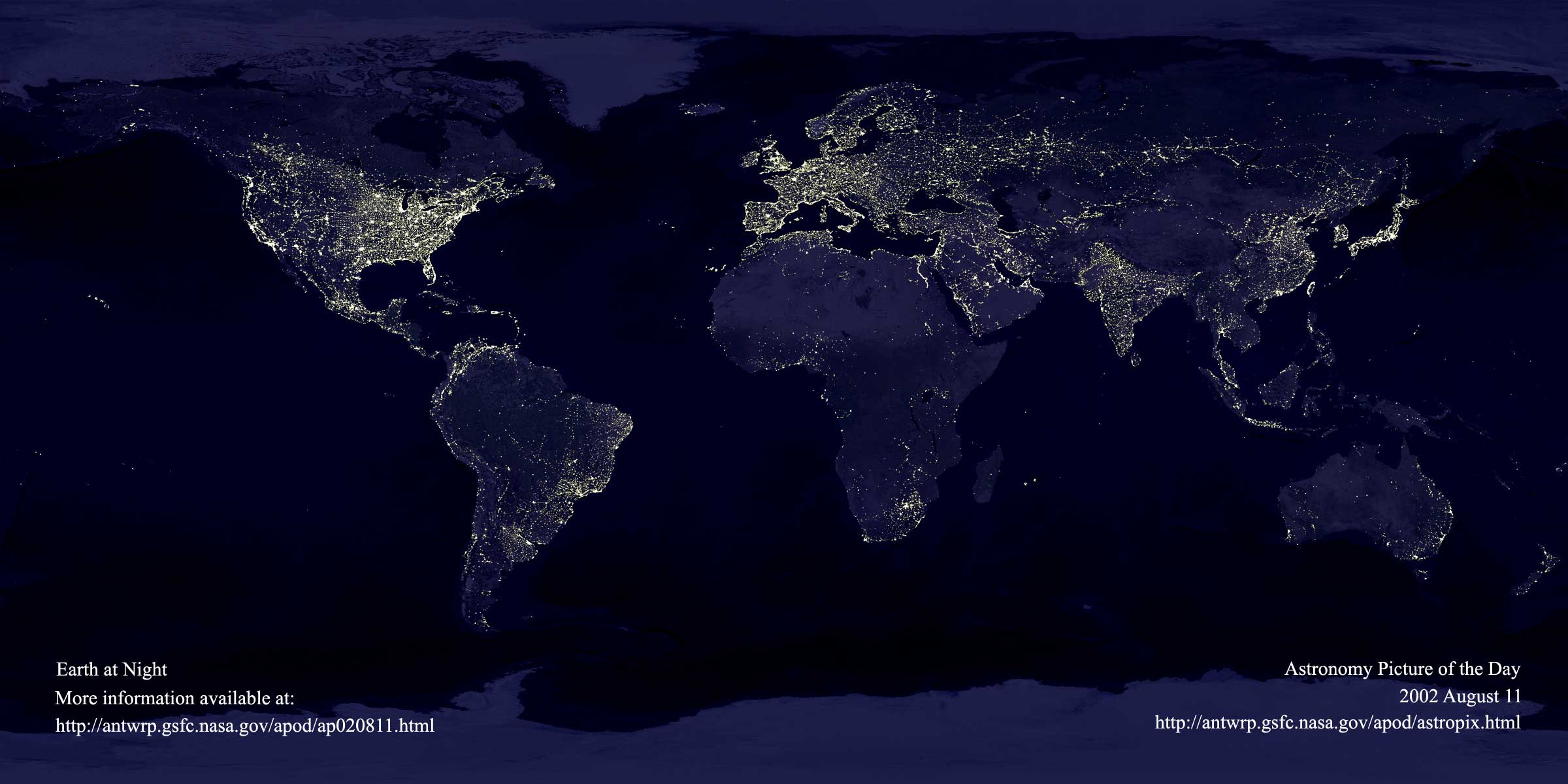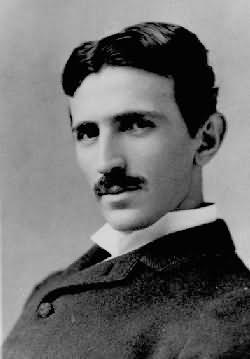
Welcome to the Tesla Memorial Society of New York Website
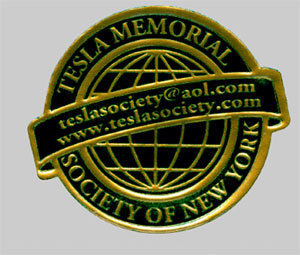
Australia is celebrating the 150th anniversary
of the birth of Nikola Tesla
by Prof Jasmina Vujic, Dr.
Ljubo Vujovic, Catherine Madden and Kevin Chong
"Were we to seize and eliminate from our industrial world the result of Mr. Tesla's work, the wheel of industry would cease to turn, our electric cars and trains would stop, our towns would be dark and our mills would be idle and dead."
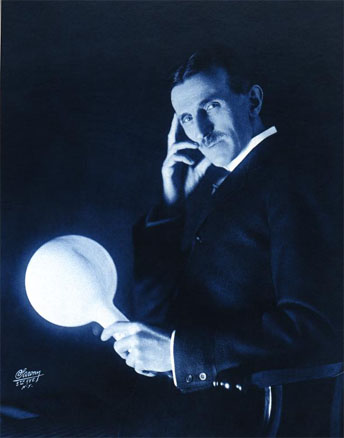
Nikola Tesla holding a gas-filled phosphor-coated light bulb which was illuminated without wires by an electromagnetic field from the "Tesla Coil".
Tesla Induction Motors
Tesla Induction Motor is
one of the ten greatest discoveries of all times, this is the power of
the world.
The Westinghouse Collection
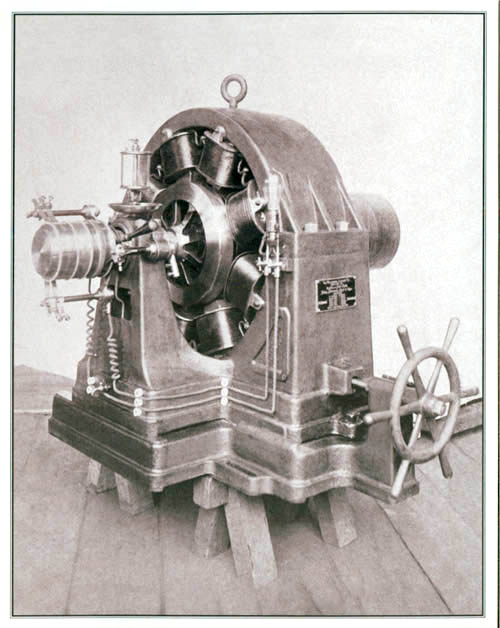
Above: Tesla Induction Motor, Westinghouse Collection.
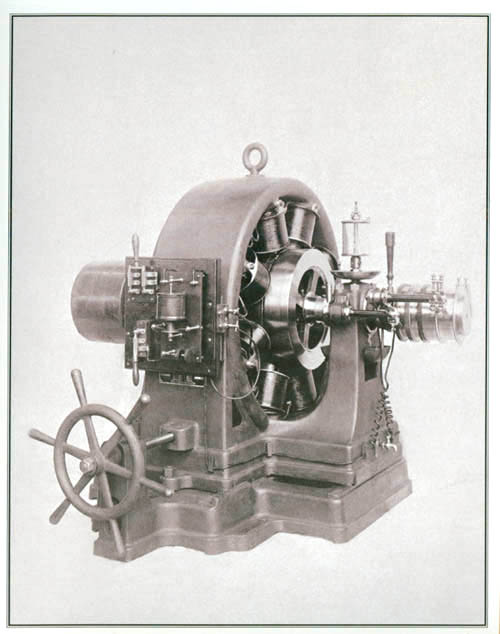
Above: Tesla Induction Motor, Westinghouse Collection.
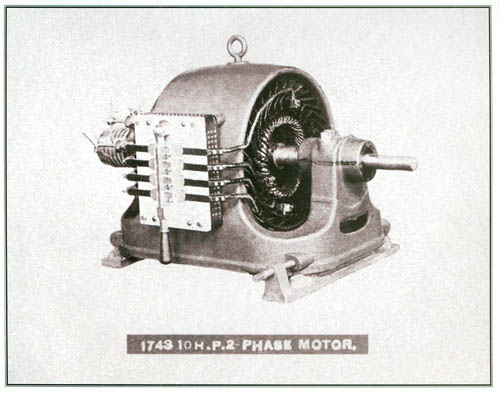
Above: Tesla Induction Motor, Westinghouse Collection.
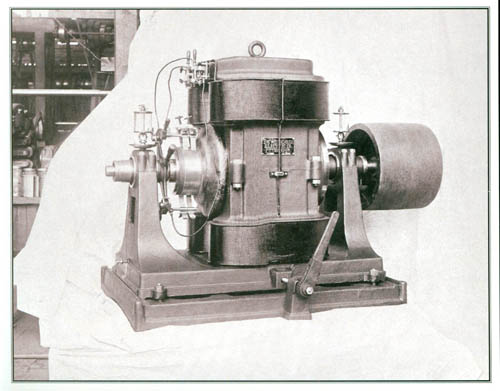
Above: Tesla Induction Motor, Westinghouse Collection.
Click here for the article of Serbian newspaper "Vesti" about the celebration in Australia
Above: Earth at Night, Click to Enlarge
"Nikola Tesla: The Genius Who Lit the World"


Above: American Actor Frenk Tabbita in a monodrama "Tesla", Octagon Theatre, University of Western Australia, Perth, Australia, July 6, 2006. More that 700 people attended the Tesla Play.http://www.teslaplay.com/

Above: Tesla Conference – Robyn McClellen (US Consul General), Milivoje Glisic (Ambassador of Serbia), Prof Jasmina Vujic (UC Berkeley & Tesla Memorial Society New York), Dr Judy Edwards MLA (former Minister for Science and Environment), Perth Convention Centre, Nikola Tesla International Conference " The Man Who Lit the World", July 7, 2006, Perth, Asutralia

Above: Tesla Bust Unveiling Ceremony, Serbian Club, Maddington WA, July 9, 2006 Prof. Dr Jasmina Vujic and Ambassador Milivoje Glisic

Above: Tesla Bust, Author Jovan Radanovic

Above: The Hon Dr. Judy Edwards MLA (former Minister for Science and Environment in Australia) unveiling Tesla Bust at the University of Western Australia, July 10, 2006, Perth, Australia

Above: Tesla Bust Unveiling Ceremony - Branislav Grbovic (Chairman - Tesla Forum); Prof Dr Jasmina Vujic (University of California in Berkeley & Tesla Memorial Society of New York), The Hon Dr. Judy Edwards MLA (former Minister for Science and Environment); His Excellency Milivoje Glisic (Ambassador of Serbia); Frank Tabbita (actor and author of Tesla Play, USA). July 10, 2006.Department of Electrical Engineering, University of Western Australia, Perth, Australia
http://sciencewa.net.au/science_archive.asp?pg=30&NID=736
WA celebrates the
man who lit up the world
by Catherine
Madden
Wednesday, 14 June 2006
|
|
THE 150th anniversary of the birth of scientist and inventor Nikola Tesla is taking place next month – and one of the world’s biggest celebrations is in Western Australia.
The Perth-based Tesla Forum is staging a conference, a dinner and a play from July 6 to 10. The events culminate with the unveiling of a bronze bust of the groundbreaking scientist at the University of Western Australia.
Among the conference speakers at the Perth Convention Centre on July 7 will be Serbia's ambassador to Australia, Milivoje Glisic, and Professor Jasmina Vujic from the University of Berkeley, California.
Acclaimed WA academics, including physicists Prof David Blair and Prof Igor Bray, will talk about how Tesla’s work has become the basis for exciting research in areas such as gravitational waves, quantum mechanics and lasers.
“This year there are four big international celebrations of Tesla’s birthday – in Belgrade, Canada near Niagara Falls, Croatia and Perth,” says Tesla Forum chairman Branislav Grbovic.
Tesla died in 1943 but his inventions are still very much part of the fabric of our daily lives. Among his more than 700 ground-breaking patents are those for the alternating current – responsible for modern electrical systems – radio, fluorescent and neon light, radar, remote control and the automobile ignition coil.
He was also a great philanthropist who was determined that his inventions were “for the service of mankind” rather than pure profit.
Yet, Mr Grbovic says, many people are still unaware of the genius of the Serbian-American who died, aged 86, virtually penniless and alone in a New York hotel room.
In 2003 he and a group of Serbian friends came together, eager to promote the legacy of Tesla, a hero in their homeland.
“We believed there was no real understanding of what this guy has done,” Mr Grbovic says.
“He is a great role model and an inspiration for everyone, especially kids.
“So we organised a lecture with the help of (the Institution of) Engineers Australia. We thought maybe 20 or 30 people would show up. It was unbelievable – it was a full house.
“We got fired about this and decided to form a group to promote Tesla and to promote science. Whatever we have tried to do we have succeeded.”
Since then the forum has become a multicultural non-profit organisation with about 75 members and the support of private companies, educational bodies and WA universities.
“Tesla wanted to unify the world and his legacy belongs to everyone,” Mr Grbovic says. “What we are trying to do is to spread this message to the public and it is working well.”
The forum has established the annual Tesla Medal, which is awarded to UWA students with the highest marks in experimental physics and electromagnetic theory and Curtin University’s best student in electrical systems.
One of the group’s other objectives was to have a street named after Tesla - this too has been achieved with Tesla Drive in Wangara due to be commissioned this year.
The City of Rockingham has also agreed to name a new street after the scientist.
“I have never found anything that people are more supportive of than our work to promote Tesla,” Mr Grbovic says.
The Tesla Forum’s bid to lobby the United Nations to proclaim an international Nikola Tesla Day on July 10 has won the support of Prime Minister John Howard, former premier Geoff Gallop, the US Consul-General in Perth, Robin McClellan, and Murdoch and Curtin universities, as well as UWA.
“Tesla’s legacy can be seen across civilisation wherever electricity is used,” says Murdoch Pro-Vice Chancellor Andris Stelbovics.
“Tesla considered his exploration of various questions raised by science as, ultimately, a means to improve the human condition with the principles of science and industrial progress, and one that was compatible with nature.”
He says a Nikola Tesla Day would recognise science, technology, peace and cooperation.
Born in 1856 in Smiljan, a village in present-day Croatia, Tesla worked as an electrical engineer in Europe before immigrating to the United States in 1884.
He quickly found a job with inventor Thomas Edison but their differences soon became apparent: Edison worked with direct electrical current, rejecting Tesla’s claims that alternating current was more efficient and reliable.
After developing several successful inventions for Edison’s company, Tesla left and sold his AC technology to George Westinghouse, founder of the Westinghouse electric company.
The advantages of alternating current over Edison’s system became obvious when Westinghouse used Tesla’s system to light the World Columbian Expo in Chicago in 1893.
By mid-1895 the world’s first commercial hydroelectric AC power plant was operating at Niagara Falls. The plates on the massive generators bore Tesla’s name.
To this day, virtually every electric induction motor around the world is based upon one of Tesla’s original designs.
When Tesla was 41, he filed the first basic radio patent and a year later, he demonstrated a radio-controlled boat.
His experiments ranged from an exploration of electrical resonance to new types of generators and steam turbines. He developed early prototypes of the X-ray, the microscope and magnetic resonance imaging (MRI). The Tesla coil is used today in radio and television sets.
Tesla is also said to have contributed to knowledge of robotics, ballistics, computer science and nuclear physics.
Yet his eccentric personality meant he was often dismissed as a mad scientist and his lack of business acumen meant he never received the financial rewards he deserved.
Tesla was declared bankrupt in 1916 and credit for his inventions was sometimes taken by others.
He had to watch as Guglielmo Marconi was awarded the Nobel Prize for radio in 1907. It was not until after his death that the US Supreme Court recognised Tesla’s right to the claim with his patent filed many years before Marconi’s.
He has become more widely appreciated since his death and researchers still scour his notebooks in the hope of finding another world-changing invention.
For more information about Tesla and the 150th birthday events, visit www.teslaforum.com.
Lighting up the world -- again
KEVIN CHONG
Globe and Mail Update
July 1, 2006
http://www.theglobeandmail.com/servlet/story/
RTGAM.20060701.wxtesla01/EmailBNStory/Science/home
Nikola Tesla harnessed the alternating current, invented radio technology and patented 700 inventions, including the wireless remote control and spark plugs. But by 1943, the inventor died alone of a heart attack in a New York hotel room -- a fringe figure, an also-ran in the scientific community. He was impoverished, obsessed with the number three and saw the Nobel Prize awarded to another man for an invention he had created years earlier.
"Nikola Tesla's ideas," The New York Times wrote in his obituary, "bordered increasingly on what some considered the fantastic as he advanced in age." Still, as Tesla once insisted: "The present is theirs, the future is mine."
That future, it seems, is now. This year -- the 150th anniversary of Tesla's birth -- Belgrade International Airport will be renamed the Nikola Tesla Airport. On the Canadian side of Niagara Falls, a statue will be unveiled to honour the man whose work enabled the construction of the world's first hydroelectric power plant. And starting this month, scientists from around the world are recognizing Tesla at conferences in Serbia, Croatia, Australia, Canada and the United States.
Tesla is also the mad scientist of choice among hipsters. He's appeared in novels, plays, an opera and a Japanese manga comic and is the subject of numerous songs -- including a few by a popular 1980s band named after him. In Jim Jarmush's 2004 film Coffee and Cigarettes musician Jack White demonstrates the Tesla coil. Later this year, David Bowie will play the Serbian-American in The Prestige, a film directed by Christopher Nolan (Memento, Batman Begins).
On the stroke of midnight July 9, 1856, Tesla was born to Serbian parents in Smiljan, Lika, in what is now Croatia. His father was a Serbian-Orthodox priest; his mother was the inventor of a number of household appliances including the mechanical eggbeater.
Tesla's own ability to visualize inventions in precise detail started in early childhood. When he saw a steel engraving of Niagara Falls, for instance, he imagined a wheel being turned by the water -- thirty years before a hydroelectric plant became reality.
After studying mechanics, physics and engineering in Austria and Czechoslovakia, Tesla worked as an electrical engineer in Hungary and France. He then emigrated to New York in 1884, where he joined Thomas Edison's laboratory.
Within a year the two had split over the alternating current. Edison tried to show the dangers of AC by using it to electrocute dogs and horses in public exhibitions. Tesla later responded with a demonstration at the 1893 World's Fair in Chicago. As Paul Auster writes in his novel Moon Palace, Tesla -- who was 6 foot 6 and cut an impressive figure in a black Prince Albert coat and derby hat -- performed "magic tricks with electricity, spinning little metal eggs around the table, shooting sparks out of his fingertips."
Tesla won the "war of the currents," of course. The industrialist George Westinghouse eventually purchased the patent for AC power. And as W. Bernard Carlson, a history professor at the University of Virginia who's writing a biography of Tesla, says, "He was as popular, if not more, than Edison."
Other battles proved more challenging. Though Tesla invented the radio in 1895, Guglielmo Marconi -- who used one of Tesla's oscillators to send signals across the English Channel -- snagged the patent in 1904 and later won the Nobel Prize. Despite a U.S. Supreme Court ruling that awarded the patent posthumously to Tesla in 1943, Marconi continues to be considered the father of the airwaves.
Radio proved problematic in other ways, too. In 1899, while experimenting with high-voltage, high-frequency electrical currents on a high plateau in Colorado, Tesla believed he received radio signals from aliens. This made him a laughingstock among his peers (though it did inspire cults who believed Tesla himself was an alien).
Tesla's reputation might not have deteriorated over his lifetime if his financial savvy was anywhere close to his scientific genius. Marconi, a wealthy Italian nobleman, had strong financial backing for his quest to win the radio patent. Tesla was so inept in his finances that he tore up his royalty agreements with Westinghouse -- foregoing millions -- when the industrialist went through a temporary financial crisis brought on by the costly P.R. battle with Edison.
Money troubles also prevented Tesla from continuing research on one of his great obsessions: the wireless transmission of electricity. Tesla's dream was to provide energy freely to everyone, but because financiers did not see much profit in this utopian scheme, the deed to his laboratory had to be sold to settle debts.
Tesla's revival first picked up steam around the 1980s, when his outlandish claims begun to make sense to scientists. Take those alien signals. Dr. Jasmina Vujic, a nuclear engineering professor at UC Berkeley says, "We now know that many stars -- pulsars -- do emit radio emissions."
Science historians also noted that Tesla's work on a "death ray" -- a final project that he claimed could destroy 10,000 airplanes from 260 miles away and that he hoped would end all war -- was similar to Ronald Reagan's Space Defence Initiative or "Star Wars" project. (Conspiracy theorists point out that, after Tesla's death, J. Edgar Hoover's FBI confiscated his research and other belongings.)
Tesla's work on robotics and wireless communications networks have proved prescient as well. And his designs for a bladeless turbine and a pump without any moving parts (modelled after a diode) still intrigue contemporary engineers. "I would say that most of Tesla's concepts have been built upon and extended," says Todd Wilkie, an electrical engineer who's worked with Intel.
According to Mr. Carlson, Tesla is especially relevant in 2006 because "technology is dehumanizing; it debases us. Tesla allows people to celebrate technological progress in a very intuitive, spiritual way."
Moreover, Tesla is a unifying figure in the Balkans. Serbia and Croatia both regard him as a "native son." He appears on the Serbian 100-dinar banknote. He's also been commemorated with his own stamp in the United States, and societies of Tesla admirers burnish his memory in over 20 countries -- including Greece, Brazil and Korea. The scientific community has even honoured him by naming a unit of magnetic-flux density, which is used to calibrate MRI machines, "the tesla."
Then there's the alternating current. Dr. Alan Bristow, a researcher in physics at the University of Toronto says, "AC motors are the workhorse of modern-day society, without which we would not have most of our household appliances or any forms of modern industry."
As for Tesla's presence in pop culture? "He was an inventor and an artist," says playwright Kevin Kerr, who co-wrote Brilliant, a play about Tesla. "He loved beautiful things. The objects he designed were highly practical and usually revolutionary inventions, but they also always had to be aesthetically pleasing."
The story of a visionary who died with his genius unrecognized is of obvious interest to artists too. Tesla appears as a doomed romantic figure in the Handsome Family song Tesla's Hotel Room. The inventor's final days are elegiacally called "the last days of wonder, when spirits still flew/round bubbling test tubes in half-darkened rooms."
In the end, it's not Tesla's now-recognized achievements that capture the public imagination, but his failures -- so idealistically and extravagantly conceived -- and his bold unfulfilled promise.
Kevin Chong is a Vancouver novelist and freelance writer.
